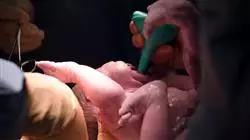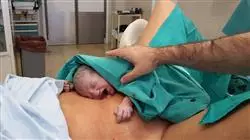University certificate
The world's largest faculty of nursing”
Introduction to the Program
The Postgraduate diploma in Assistance and Care of Women in Childbirth for Midwives contains the most complete and up-to-date scientific program on the market"

The midwife works in the care and attention of pregnant women ensuring their hygiene, comfort, psychological support and nutritional care, as well as her own safety, development and overall health: the basic principles to ensure effective care. Thanks to the evolution of low-intervention childbirth proposed by the Ministry of Health and Social Policy, the different health professionals who work with pregnant women must provide adequate and effective care, reduce unnecessary interventions to a minimum and ensure their privacy, as well as promote newborn care such cleaning, placing identification bracelets, etc., in close contact with the mother, thereby favoring the mother-child bond.
The role of the midwife in the evolution of the pregnant woman, postpartum and her newborn is paramount, procured by professionals dedicated directly to the care of women, since the joint knowledge enables us to achieve a level of care in accordance with the recommendations on normal childbirth, as well as La latest standards developed in the Clinical Guide for Normal Childbirth published by the Ministry of Health and Social Policy in this same year.
This line of thought and action coincides with a strong change that has to take place in the relationship between health teams and the woman user, to move from a technical relationship to one in which the bioethical principle of autonomy and attention to the integrity of the person involved is prioritized. The aim is to comprehensively address the process that women face during childbirth and thus improve health outcomes for them and their babies.
The general purpose of this educational proposal is to update the skills and knowledge of midwives to meet the health needs of people with scientific rigor and the highest professional level. This training was created in response to multiple needs in the hospital environment for all professionals, both for those recently incorporated and those who have been providing their professional services for some time and who require constant up-to-date training in this very specific area of practice.
Increase your competencies in the approach to the Assistance and Care of Women in Childbirth for Midwives through this program”
This Postgraduate diploma in Assistance and Care of Women in Childbirth for Midwives contains the most complete and up-to-date scientific program on the market. The most important features include:
- Development of clinical cases presented by experts in the different areas of multidisciplinary knowledge
- The graphic, schematic, and practical contents with which they are created provide scientific and practical information on the disciplines that are essential for professional practice
- Latest news on Assistance and Care of Women in Childbirth for Midwives
- An algorithm-based interactive learning system for decision-making in the clinical situations presented throughout the course
- With a special emphasis on evidence-based nursing and research methodologies in Labor and Delivery Assistance
- All of this will be complemented by theoretical lessons, questions to the expert, debate forums on controversial topics, and individual reflection assignments
- Content that is accessible from any fixed or portable device with an Internet connection
This Postgraduate diploma is the best investment you can make when selecting a refresher program, for two reasons: in addition to up-to-date your knowledge in Midwifery for Midwives, you will obtain a Postgraduate diploma from TECH Global University"
It includes, in its teaching staff, health professionals belonging to the field of obstetric-gynecological health, who contribute to this program with the experience of their work, in addition to recognized specialists belonging to scientific societies of reference.
Thanks to its multimedia content developed with the latest educational technology, they will allow the professional a situated and contextual learning, that is to say, a simulated environment that will provide an immersive learning programmed to prepare in real situations.
The design of this program is based on Problem-Based Learning, by means of which the midwife will have to try to solve the different professional practice situations that arise during the program. For this purpose, she will be assisted by an innovative interactive video system developed by recognized experts in the field of obstetric-gynecological health and with great teaching experience.
Increase your confidence in decision making by updating your knowledge through this Postgraduate diploma in Assistance and Care of Women in Childbirth for Midwives"

Don't miss the opportunity to update your knowledge in Assistance and Care of Women in Childbirth to improve patient care"
Why study at TECH?
TECH is the world’s largest online university. With an impressive catalog of more than 14,000 university programs available in 11 languages, it is positioned as a leader in employability, with a 99% job placement rate. In addition, it relies on an enormous faculty of more than 6,000 professors of the highest international renown.

Study at the world's largest online university and guarantee your professional success. The future starts at TECH”
The world’s best online university according to FORBES
The prestigious Forbes magazine, specialized in business and finance, has highlighted TECH as “the world's best online university” This is what they have recently stated in an article in their digital edition in which they echo the success story of this institution, “thanks to the academic offer it provides, the selection of its teaching staff, and an innovative learning method aimed at educating the professionals of the future”
A revolutionary study method, a cutting-edge faculty and a practical focus: the key to TECH's success.
The most complete study plans on the university scene
TECH offers the most complete study plans on the university scene, with syllabuses that cover fundamental concepts and, at the same time, the main scientific advances in their specific scientific areas. In addition, these programs are continuously being updated to guarantee students the academic vanguard and the most in-demand professional skills. In this way, the university's qualifications provide its graduates with a significant advantage to propel their careers to success.
TECH offers the most comprehensive and intensive study plans on the current university scene.
A world-class teaching staff
TECH's teaching staff is made up of more than 6,000 professors with the highest international recognition. Professors, researchers and top executives of multinational companies, including Isaiah Covington, performance coach of the Boston Celtics; Magda Romanska, principal investigator at Harvard MetaLAB; Ignacio Wistumba, chairman of the department of translational molecular pathology at MD Anderson Cancer Center; and D.W. Pine, creative director of TIME magazine, among others.
Internationally renowned experts, specialized in different branches of Health, Technology, Communication and Business, form part of the TECH faculty.
A unique learning method
TECH is the first university to use Relearning in all its programs. It is the best online learning methodology, accredited with international teaching quality certifications, provided by prestigious educational agencies. In addition, this disruptive educational model is complemented with the “Case Method”, thereby setting up a unique online teaching strategy. Innovative teaching resources are also implemented, including detailed videos, infographics and interactive summaries.
TECH combines Relearning and the Case Method in all its university programs to guarantee excellent theoretical and practical learning, studying whenever and wherever you want.
The world's largest online university
TECH is the world’s largest online university. We are the largest educational institution, with the best and widest online educational catalog, one hundred percent online and covering the vast majority of areas of knowledge. We offer a large selection of our own degrees and accredited online undergraduate and postgraduate degrees. In total, more than 14,000 university degrees, in eleven different languages, make us the largest educational largest in the world.
TECH has the world's most extensive catalog of academic and official programs, available in more than 11 languages.
Google Premier Partner
The American technology giant has awarded TECH the Google Google Premier Partner badge. This award, which is only available to 3% of the world's companies, highlights the efficient, flexible and tailored experience that this university provides to students. The recognition as a Google Premier Partner not only accredits the maximum rigor, performance and investment in TECH's digital infrastructures, but also places this university as one of the world's leading technology companies.
Google has positioned TECH in the top 3% of the world's most important technology companies by awarding it its Google Premier Partner badge.
The official online university of the NBA
TECH is the official online university of the NBA. Thanks to our agreement with the biggest league in basketball, we offer our students exclusive university programs, as well as a wide variety of educational resources focused on the business of the league and other areas of the sports industry. Each program is made up of a uniquely designed syllabus and features exceptional guest hosts: professionals with a distinguished sports background who will offer their expertise on the most relevant topics.
TECH has been selected by the NBA, the world's top basketball league, as its official online university.
The top-rated university by its students
Students have positioned TECH as the world's top-rated university on the main review websites, with a highest rating of 4.9 out of 5, obtained from more than 1,000 reviews. These results consolidate TECH as the benchmark university institution at an international level, reflecting the excellence and positive impact of its educational model.” reflecting the excellence and positive impact of its educational model.”
TECH is the world’s top-rated university by its students.
Leaders in employability
TECH has managed to become the leading university in employability. 99% of its students obtain jobs in the academic field they have studied, within one year of completing any of the university's programs. A similar number achieve immediate career enhancement. All this thanks to a study methodology that bases its effectiveness on the acquisition of practical skills, which are absolutely necessary for professional development.
99% of TECH graduates find a job within a year of completing their studies.
Posgraduate Diploma in Assistance and Care of Women in Childbirth for Midwives
Midwives are essential professionals in the field of Health, as they have the responsibility to accompany women throughout the process of childbirth and postpartum. Their work, therefore, requires constant updating to ensure the safety and well-being of the mother and the newborn. For this reason, the Posgraduate Diploma in Assistance and Care of Women in Childbirth for Midwives has been designed with the main objective of providing you with the most updated care in this field of Nursing, thus perfecting your health practice.
Study a first class academic program
Do you want to learn the latest techniques for pain management during childbirth, the most advanced care to avoid complications in the process and sophisticated strategies to carry out an adequate monitoring of the mother and newborn during the postpartum period? This Posgraduate Diploma in Assistance and Care of Women in Childbirth for Midwives is your best option! Update yourself in this branch of Nursing in a 100% online way and from the hand of experts with an extensive hospital career behind them.







